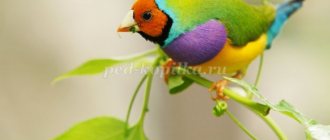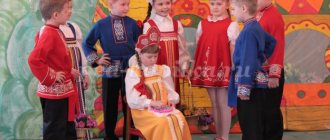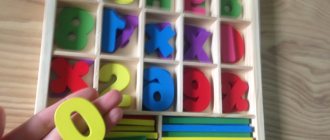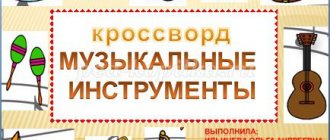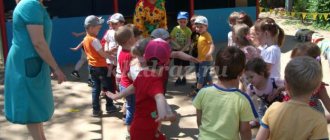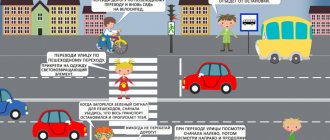What mathematical concepts do children in the second junior group study?
In order for FEMP planning in a group to be as competent and effective as possible, it is important to understand what concepts are accessible to the intelligence of children at this age.
So, the 2nd youngest learns to operate with the following concepts:
- Quantity. My task at this stage is to develop the children’s ability to understand and identify the common feature of objects of one group: these oranges are all orange, round, large. We learn to independently group objects according to the same characteristics: select all red balls, all small ones, etc. Understand the meaning of the words one, many, none, one at a time. Understand the concept of “how much” and be able to give an answer using the words many, one, none.
We also learn to make a simple comparative analysis of identical and unequal quantities or groups of objects through mutual comparison of objects. We begin to understand the concept of equal, not equal, what is more, what is less.
- Magnitude. Again, we understand the meaning of concepts through comparison of objects or groups of objects: by comparing them with each other, we realize which of them is large and small in size. By comparing by height, we will understand which object is tall and low. Similarly, in length - long, short, and in width - narrow, wide. We also compare identical or different objects according to a given parameter (height, width, etc.);
- Form. We study geometric shapes: triangle, circle, square. We learn to explore the shape of objects through vision and touch. We understand that a circle has no corners, beginning or end. It is convenient to use surrounding objects to study geometric shapes;
- Space. We learn to navigate in space, to understand what is in front, behind, above, below. At the same time, we learn where our right hand is and where our left hand is. When learning these concepts, I use furniture in a group setting, it makes it easier to explain: the chair is in front or to the right. Often, before preparation and even later, children confuse right and left. To prevent this, individual work with children who find it difficult to navigate in space is appropriate;
- Time. Cognitive development in this direction is carried out by studying the signs by which night or day, morning or evening are determined.
General information about the formation of primary mathematical knowledge in children
The mathematical development of children in kindergarten is carried out strictly according to the Federal State Educational Standard, in accordance with the age characteristics of the children. As a teacher, I set children tasks that are feasible for their intelligence and help them find answers. At the same time, the formation of elementary ideas about the concepts of mathematics is carried out not only in preschool educational institutions, but also at home.
I do not mean counting and other mathematical operations, but the simplest concepts of size, shape, time, space, quantity. The main form of education for children is classes, and they are planned taking into account the principles of science, accessibility, individual approach, systematicity, clarity, connection with life, etc.
Games are the most suitable form of teaching for preschoolers. Therefore, I practice such classes for the little ones, where didactic games and entertaining developmental exercises are always used. Typically, FEMP classes are conducted for the entire group simultaneously, frontally. But only in the 2nd junior school is it recommended to divide children into subgroups at the beginning of the school year, so that they gradually learn to study together.
Mathematics in the garden does not take much time - only 1 lesson per week for little ones, 2 for older ones. At first, the duration of the lesson does not exceed 15 minutes, gradually increasing to 25-30 minutes in the preparatory group. NED (direct educational activities) are planned so that children gradually learn concepts and can see their own success.
The children and I study each program task over several lessons and constantly return to the material covered throughout the school year. This ensures good assimilation of the material.
But we consider not only mathematical topics in the classroom; in parallel, speech, logic, and thinking are developed, and educational goals are achieved that shape the child’s personality. Take my word for it that the development and training program in kindergarten is an extremely complex mechanism that should ensure high-quality preparation of children for school and lay down positive skills for a happy and fulfilling life.
What should a child of the 2nd junior group be able to do by the end of May?
Spring ends, and with it, kindergarten classes stop and results are summed up.
What should I teach kids about math:
- The ability to independently group objects based on common characteristics (shape, color, size);
- Be able to find one object that is not like all the others;
- Distinguish between the concepts one and many;
- Understand the meaning of the concepts more, less, the same, not the same;
- Correlate groups of objects by quantity: more or less, the same;
- Be able to identify features by length, height, width;
- Know simple geometric shapes - triangle, circle, square;
- Distinguish between where the right hand is and where the left hand is, and the directions - in front, behind, above, below, above, below;
- Know and understand the meaning of the words morning, day, night, evening.
Does all this seem complicated to you? In fact, for kids, such math classes are fun, because we play, travel, talk in class, and don’t drill into dry theory...
In the learning process, I use technological maps and other didactic material so that cognition as a thought process occurs naturally, without tension. My task for FEMP is to make the study of primary concepts of mathematics exciting, unusual, fabulous, in order to form a lasting interest in science during the school period.
We do math projects with the kids, I already wrote about project activities in kindergarten, I won’t repeat myself.
So, but I’ll move on to the process of compiling notes on FEMP for the 2nd junior group. You can choose any topics: transport, vegetables, create game situations.
The lesson is a kind of presentation for kids about the wonderful world of mathematics. Therefore, it is so important to show children the attractiveness of mental activity at first.
Books are the key to a teacher’s methodological knowledge
We, teachers, cannot do without self-education, and, therefore, independent study of literature on the upbringing and training of preschoolers. It gives me great pleasure to find new cool manuals and training manuals for myself and my colleagues. It’s not difficult, because all I have to do is “go” to the catalog of the UchMag online store, and I immediately find everything I need.
Let's say you are planning an open math lesson for a younger group. You need to take notes, right?
I have made a good selection of thematic literature:
- "Mathematics. Second junior group: planning, notes on game activities” - with the help of these materials you will be able to build a FEMP training system in the 2nd junior group;
- “Formation of elementary mathematical concepts in preschoolers. Lesson notes. 2nd year of study” - the materials fully comply with the requirements of educational programs approved by the Ministry;
- “Formation of elementary mathematical concepts. The first and second junior groups of kindergarten" (Pomoraeva I.A., Pozina V.A.) - a CD with excellent materials, designed in the form of a set of play activities and exercises;
- “Knowledge of the objective world. Junior group (from 3 to 4 years old)” - the manual will help the teacher realize the goals set by the general education program;
- “Thematic planning. Complex classes according to the program “From birth to school” edited by N.E. Veraksy, T.S. Komarova, M.A. Vasilyeva. Second junior group" - a CD that contains all the necessary materials in order to draw up a competent long-term lesson plan for FEMP.
I think we need an electronic file cabinet of methodological literature, what do you think? I’ll probably take up this issue in my spare time (which is practically non-existent).
